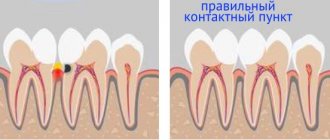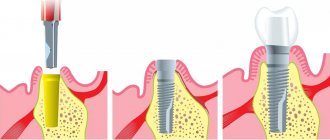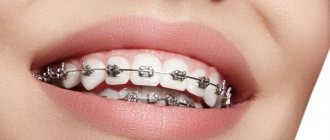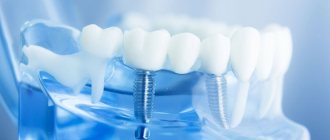During the examination, the dentist may suggest that you replace the previously installed filling with a new one. This proposal is often misunderstood:
“Doctor, this tooth doesn’t bother me, and the filling is still holding. Why change it?!”
To understand why replace an old filling with a new one, let’s figure it out: what is the function of the filling and why was it placed in the first place?
The filling restores the function of the tooth, aesthetics, protects the pulp (dental nerve) from infection, and the tooth from further destruction.
If the destruction of enamel and dentin has gone so deep that it has approached the pulp of the tooth, the “nerve” will need to be removed. “But it can be treated,” you say. Of course, the doctor will remove the tooth pulp, fill the canals and put a filling. You will learn more about canal treatment in the article Why you cannot give a 100% guarantee on tooth root canal treatment.
The problem is that after complex, lengthy and expensive root canal treatment, the tooth will become “dead” - these are not empty words. After removal of the pulp, hard tissues cease to be moistened and the walls of the tooth become fragile. Pulpitis shortens the lifespan of your tooth.
Now let's get back to replacing the old filling with a new one. The main reason for replacing an old filling with a new one is the loss of tightness of the filling of a former carious cavity. If the old filling does not prevent infection from entering the tooth, then the carious process resumes, and we already know what the consequences are.
Secondary caries develops unnoticed and cannot be detected without examination by a dentist.
In what other cases is it necessary to replace an old filling with a new one?
In what cases is it necessary to install a filling?
The installation of restorative material is carried out not only in the treatment of carious lesions. The procedure is also performed when:
- presence of chips and cracks;
- elimination of consequences after mechanical damage;
- intense loss of hard tissues, leading to almost complete wear of the upper part of the teeth (for example, due to involuntary grinding of the jaws).
It is worth noting that any dental clinic performs filling only in cases where the destruction of the coronal part is insignificant. If the surface of the tooth is damaged by more than a third, it is replaced with an artificial substitute - a prosthesis.
The use of modern materials helps restore the beauty of the smile and chewing function, and also prevents further destruction of the mineralized coating.
Other indications for replacing an old filling
Subsidence of the filling . Over time, the material from which the filling is made shrinks (vertical and horizontal).
When the filling subsides vertically, the height of the bite changes, which can cause dysfunction of the temporomandibular joint. In addition, the shrinkage of the filling changes the height of the contact point between the antagonist teeth (teeth of the upper and lower jaw). And since the teeth experience a lot of stress during the process of chewing food, constant pressure can cause the defective filling to collapse, and along with it, part of the tooth.
When the filling shrinks horizontally, the contact point (point of contact) between adjacent teeth disappears. While eating, food gets stuck between the teeth and constantly injures the interdental (dental) papilla. The gums become inflamed, gingivitis, periodontitis and secondary caries develop.
Overhanging edges of the filling. This defect occurs if the filling material flows onto the gum (rests on it). The overhanging edge of the filling leads to permanent injury to the gums and causes inflammation. Often such a filling causes local periodontitis (periodontitis in the area of one tooth) and secondary caries, since it is impossible to remove food debris from the resulting pocket.
The contact point is formed correctly if the dental floss (floss) forcefully penetrates the gap between the teeth, moves freely along the side surface of the tooth (does not cling to irregularities) and is pulled out with force.
Another reason for replacing an old filling is the incorrect anatomy of the chewing surface of the tooth. Most often this is a consequence of poor quality treatment. The surface of an old filling may be almost smooth and lack pronounced bumps and fissures.
The correct shape of the tooth surface provides not only an aesthetic appearance, but also the performance of chewing functions. The lack of a natural pattern on the chewing surface of the teeth does not allow for effective grinding of food and leads to gastrointestinal diseases.
When biting and grinding food, the teeth experience a heavy chewing load. In order for the antagonist teeth to connect into the correct bite and not experience strong friction against each other, they must touch at points of a small area.
The correct connection to the bite is determined, among other things, by the shape of the surface of the teeth. To create such a surface, a dentist must have a good knowledge of the anatomy of teeth and possess the skill of a sculptor.
You can also replace an old filling with a new one for aesthetic reasons. Over time, teeth and fillings will change color; this discrepancy may also be a reason to replace the filling.
What types of fillings are there?
Depending on the period of use, temporary and permanent fillings are distinguished. The first ones are placed during treatment. For example, they cover a tooth for a while in order to understand whether the nerve is affected by caries or not. A temporary filling is also used to secure medications placed in a diseased tooth, or to secure arsenic after depulpation. After two weeks, temporary materials are replaced with permanent ones. The latter can last for years.
In modern dentistry, the following types of fillings are distinguished:
- Cement fillings are a budget option. They are difficult to grind, look unnatural and can cause destruction of the teeth they interact with.
- Metal (almagamic). They are made from an alloy of silver and copper, are characterized by increased strength, but also stand out against the background of the rest of the jaw. Often, fillings of this type are installed on teeth located further than the incisors.
- Composite fillings. They have a paste-like consistency and are applied in layers, so working with them does not cause much difficulty. Special ultraviolet light is used to fix composite materials. The variety of the palette allows you to choose a shade that will not differ from the native enamel, which is why composites are widely used for the restoration of anterior teeth.
- Ceramic fillings. In appearance and composition, they are as close as possible to the natural coating of teeth. Their production takes some time, so the fixation of the material is carried out in several stages. Ceramics are resistant to temperature changes. Its main advantage is also aesthetics.
How to extend the service life of filling material
How often the filling will have to be changed depends on how correctly it is used. To extend the life of the material, just listen to the following tips:
- don’t skimp on material: very cheap means it won’t last long,
- avoid increased stress on the filling: do not open bottles, avoid excessively hard foods,
- avoid sudden changes in temperature in the oral cavity: do not take too hot or cold food,
- select oral hygiene items and products in accordance with the characteristics of the teeth.
In addition, even in the absence of complaints, you need to regularly visit the dentist for timely detection of pathologies and defects. It is better to spend a few minutes grinding than to have to refill it after some time. Preventative visits will save time and money, and will also keep your nerves and teeth in perfect order.
What types of fillings are better?
Many dentists recommend installing fillings made of light-curing composite. They are characterized by increased strength and durability, and look natural. Composite fillings are suitable for filling cavities in distant teeth and restoring carious cavities, as well as for treating erosions of hard tissues. Their service life is 5 years.
Glass ionomer cement, which is a hybrid of acrylic and silicate components, is also considered a good choice for filling. Glass ionomer combines well with natural coatings and other established types of fillings; it is suitable for treating destructive processes of the tooth, filling the anatomical space under the roots, and preparing the cavity for further orthopedic manipulations.
Light-curing composite fillings
The components of a light-curing filling react to the glow of a special lamp. The polymerization lamp emits blue light, affecting the components of the filling in a special way; the wavelength is 450 nm.
Advantages of light-curing composite fillings:
- High aesthetics
- Large color palette;
- High strength;
- Low shrinkage;
- Long service life;
- The technology allows the dentist to make a more accurate anatomical shape.
Disadvantages of light-cured composite fillings:
— Higher cost compared to other types of fillings.
In “Royal Smile” dentistry, high-quality materials and reliable specialized equipment are used for fillings. The procedure for installing a filling is carried out by experienced dentists without pain at low prices.
How is the filling installed?
The fixing of the restoration material always follows the same pattern:
- First, the doctor injects into the tissues located around the damaged area.
- When the medicine begins to act, the specialist cleans the cavity from the remains of dead tissue, darkened mineralized parts and dentin, and gives it the desired shape and depth.
- The doctor then examines the pulp. If the connective tissue is not damaged, the prepared area is treated with an antiseptic. If the pulp is in a state of inflammation, then the dentist removes it from the tooth cavity and then fills the canals.
- After the above manipulations, the cavity is dried. Then special antimicrobial and insulating gaskets are placed in it.
- At the final stage, filling is carried out. At the end of the operation, the installed material is ground for comfortable closure of the jaws and polished.
Regular dental examinations and professional hygiene
Even the most efficient and disciplined person needs additional dental care. Self-cleaning is not enough, and once every 6 months we recommend undergoing a preventive examination and comprehensive professional oral hygiene. This procedure includes cleaning teeth from plaque using ultrasound, special AirFlow technology and subsequent polishing of teeth and fillings with a special paste. This is very useful not only for teeth, but also for fillings. This polishing removes scratches, food pigments and restores the original shine.
After teeth filling
In some cases, after applying a filling, the sensitivity of the sealed tooth to external factors may increase: it may “ache” unpleasantly with any temperature change or when air enters. This most often happens when using composite materials. If the tooth remains sensitive two weeks after treatment, you should immediately consult a doctor.
A common cause of pain that occurs immediately after the anesthetic wears off can also be an excessive filling height. In this case, it should be reduced by the dentist.
The application of a filling is always accompanied by final grinding, during which the edges may remain sharp. Due to the action of the injection, this is often not felt immediately. If you notice protruding edges after the anesthetic has worn off, you should contact a dental clinic as soon as possible and make an appointment to straighten the tooth surface.
Check yourself: when to see a doctor
If a tooth hurts 2-3 days after the filling is placed, and the pain noticeably intensifies when pressed at night, this may indicate a relapse of caries and damage to the dental nerve. If black spots are visible under the filling several months after treatment, the filling interferes with the closure of the jaws or there is prolonged pain when pressing on the tooth. Do not ignore these symptoms and do not be afraid - this is a reason to contact your attending physician - all work must be carried out within the framework of the guarantee of the medical institution. Timely treatment is the key to the health of your teeth!
Rules for caring for fillings
Despite the fact that many fillings can theoretically last for years, it is recommended to change the materials every 10-12 years. It is recommended to visit a doctor once every six months for hygiene measures. You should also make an appointment with a doctor if:
- short-term pain in the treated area;
- detection of cracks;
- presence of a chip in the filling material.
The dentist can easily replace a bad filling with a new one.
If there is a large amount of restoration material in the cavity, you can ask the specialist to prescribe a gel with a high fluoride content. Its regular application will help strengthen the hard surface and prevent caries from forming again. Filled teeth may also be coated with fluoride varnish during the examination.
At home, it is recommended to use mouth rinses. With their help, you can significantly reduce the number of microbes that cause caries.
Summarizing the above, I would like to note that filling is a serious procedure. To prevent dental treatment under anesthesia from ending with repeated fillings and a double waste of time and money, you should seek help only from reliable, experienced specialists.
How does the replacement take place?
Many patients are worried: is it painful to change a filling? The procedure is performed under local anesthesia and is therefore absolutely painless.
In general terms, re-sealing occurs as follows:
- anesthesia is administered
- the desired tooth is isolated from the oral cavity with a rubber dam: so that moisture and microorganisms do not enter the treated cavity,
- old filling material and tissues affected by caries (if any) are removed
- the cavity is treated with a special etching solution and dried,
- an insulating or medicinal pad is applied,
- a new filling is applied.
Restoration takes place with mandatory consideration of the anatomical features of the chewing surface.
What to do if the filling falls out?
It may happen that the filling falls out earlier than necessary. What to do? It would be right to immediately, in the near future, go to the clinic and see the treating dentist. The doctor may place another similar filling or a permanent one, depending on the course of the disease. Be that as it may, you cannot walk around with an open tooth, eat food or do nothing. Complications may arise and the inflammatory process will begin. While it is not possible to visit a doctor, rinse your mouth as often as possible, especially after eating.
Reasons for the development of caries on a filled tooth
- Caries can reoccur if infected tooth tissue is not removed sufficiently or the filling technology is violated. Dentists call this phenomenon a relapse of caries.
- Fillings, like everything else in the world, are not eternal and have their own service life. The average service life of fillings is determined by the quality of the filling material, the size of the carious cavity and the quality of the filling (subject to oral hygiene).
Types of fillings that may need replacing
- Cement (silicate, silicophosphate) fillings – are more often used in free dentistry in district clinics. They are cheap - and that's where their advantages end. As a rule, such fillings are destroyed within a year or two, and secondary caries is almost always found underneath them.
- Amalgam fillings (silver and mercury) - very durable, but not aesthetically pleasing. Over time, they lead to a change in tooth color and contain mercury, the vapors of which are very toxic.
- Light-curing (modern photopolymer) fillings are the best choice. They are durable, allow for complete restoration with restoration of the shape and function of the tooth and look natural. The average service life of such fillings is 5 years.
At the end of their service life, fillings cease to perform their function - to seal tightly and reliably protect the tooth from microbes.
The carious process that develops under a filling is often asymptomatic, which is dangerous for patients who are accustomed to seeing a dentist only when their teeth begin to hurt. As a result, this leads to more severe consequences and complications, such as pulpitis and periodontitis. And their treatment is more complex and expensive.
What dental treatment is prohibited during pregnancy?
When treating teeth during pregnancy, you need to know what is strictly prohibited for expectant mothers.
As a substance for local anesthesia, it is prohibited to use those compositions that contain adrenaline and any of its derivatives. General anesthesia during pregnancy is also strictly prohibited.
Teeth whitening is prohibited. Dental prosthetics cannot be performed. It is prohibited to perform dental treatment using arsenic during pregnancy. Dentists are aware of all the restrictions and your task, in case your pregnancy is short, is to warn the doctor about pregnancy before starting dental treatment.
How long can you walk with a temporary filling?
A temporary filling can last for different periods of time, since everything depends on its composition, as well as on the specific disease:
- destruction of the nerve - up to 10 days with gentle means;
- treatment of periodontitis, elimination of inflammation - from 1 to 3 weeks, the time is calculated depending on the complexity and degree of the disease;
- Dentin augmentation or cyst treatment can take up to 3-6 months.
From this it can be seen that the filling is installed both for one day and for 6 months, so there is no single period - this issue is resolved individually. The filling still cannot last longer than six months, so you should plan your time in such a way as to be able to make it to the dentist’s visit - do not plan any long trips during the treatment period.
It is very important to have your teeth treated by a trusted specialist who can make an accurate diagnosis. Contact our clinic - we use the most modern instruments and filling compositions, and focus on the sterility and hygiene of the equipment. The doctor will check your teeth and, if necessary, place a temporary filling so that the treatment proceeds correctly and step by step.










